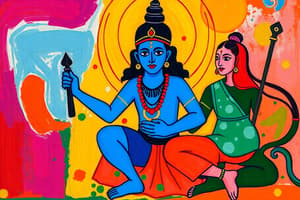Podcast
Questions and Answers
Match the term with its corresponding definition within the context of Hinduism:
Match the term with its corresponding definition within the context of Hinduism:
Samsara = The cycle of birth, death, and rebirth driven by karma. Moksha = Liberation from the cycle of rebirth. Karma = The principle of cause and effect based on one's actions. Maya = The illusion that the material world is the ultimate reality.
Match each Varna (caste) with its traditional role in Hindu society:
Match each Varna (caste) with its traditional role in Hindu society:
Brahmins = Priests and scholars responsible for spiritual knowledge. Kshatriyas = Rulers and warriors responsible for protecting society. Vaishyas = Merchants and landowners involved in economic activities. Shudras = Laborers and servants providing essential services.
Match each term with its significance in Hindu scripture and philosophy:
Match each term with its significance in Hindu scripture and philosophy:
Rig Veda = An ancient collection of Vedic Sanskrit hymns and a foundational text of Hinduism. Upanishads = Philosophical texts that explore the nature of reality and the self (Atman). Bhagavad Gita = A popular scripture that discusses dharma, karma, and devotion to God. Atman = The individual's true self, which is ultimately identical to Brahman.
Match the spiritual concept to its meaning:
Match the spiritual concept to its meaning:
Match the yoga practice with its description:
Match the yoga practice with its description:
Match the concept with the goal:
Match the concept with the goal:
The order of caste system from top to bottom:
The order of caste system from top to bottom:
Match the description with the terms:
Match the description with the terms:
Match the Hindu term with its conceptual category:
Match the Hindu term with its conceptual category:
Match the Hindu text with its key focus:
Match the Hindu text with its key focus:
Flashcards
Samshara
Samshara
The cycle of birth, misery, and death caused by karma.
Dharma
Dharma
An individual's duty, fulfilled by observing customs or laws.
Rig Veda
Rig Veda
Ancient Indian collection of Vedic Sanskrit hymns; a sacred Hindu text.
Atman
Atman
Signup and view all the flashcards
Moksha
Moksha
Signup and view all the flashcards
Brahmin
Brahmin
Signup and view all the flashcards
Avatar
Avatar
Signup and view all the flashcards
Upanishads
Upanishads
Signup and view all the flashcards
Samadhi
Samadhi
Signup and view all the flashcards
Karma
Karma
Signup and view all the flashcards
Study Notes
- Samsara constitutes the endless cycles of birth, suffering, and death, propelled by karma.
- Dharma represents one's duty, fulfilled through adherence to custom or law.
- Rig Veda encompasses an ancient Indian collection of Vedic Sanskrit hymns and stands as one of Hinduism's four sacred canonical texts known as the Vedas.
- Atman refers to the true eternal self.
- Bhagavad Gita is Hinduism's most popular sacred text.
- Moksha signifies the liberation of the individual self.
- Brahmin denotes the eternal essence of reality and the universe's source.
- Avatar is a deity's manifestation in bodily form on Earth, often as a divine teacher.
- Upanishads are documents containing the central teachings of Hinduism.
- Samadhi is the highest state of consciousness attainable through meditation.
- Karma dictates that every action produces a reaction or outcome.
- Maya is the force that creates the cosmic illusion that the phenomenal world is real.
- Shudras are peasants and artisans within the caste system.
- Sati is the practice where a Hindu widow immolates herself on her deceased husband's funeral pyre.
- The untouchables are individuals considered impure and less than human due to their birth into a specific caste.
The Caste System (Top to Bottom)
- Brahmins (priests) occupy the highest position.
- Kshatriyas (kings, rulers, warriors) hold the second position.
- Vaishyas (landowners, skilled workers, merchants, craftsmen) are third.
- Shudras (servants, farm workers) are placed in the fourth tier.
- Outcasts (street sweepers, human/animal waste removers) are outside the caste system.
Four Goals in Life
- Sensual pleasure
- Marital status
- Harmony with dharma
- The bliss of moksha
Studying That Suits You
Use AI to generate personalized quizzes and flashcards to suit your learning preferences.




